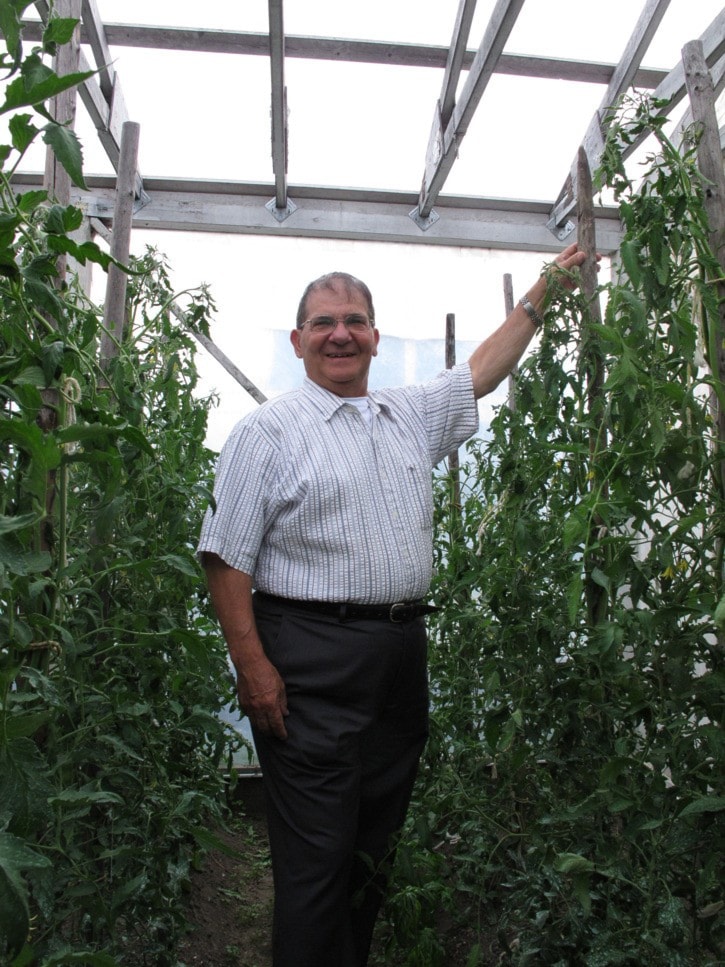A friend, who lives near Southside Market, shared his apprehensions about getting his garden prepped for this year. “There’s a lot of pressure in that zone to get your backyard to perform! No wimpy gardens allowed in Little Italy,” he said with a laugh. I’ve heard that part of town referred to as “Little Italy” in reference to the Italian heritage of people living there. Recently, I had the chance to explore one of the backyards in this area, which showcased the reverence for fresh food inherent to Italian culture.
Extremely proud of what lies beyond the gate to his back yard, Joe Iaccino presented what must be one of the most productive yards in Revelstoke. Almost every bit of space that lies within approximately 1,400 square feet of yard area had been put to use. Included in Joe’s garden at the time of my visit were cabbage heads larger than my own head, broccoli plants in their second stage of harvest, a third sowing of salad greens ready for harvest, hearty greens such as kale and chard about two feet high, tomato plants standing over five feet (housed in an unheated greenhouse), pepper plants with visible fruit, pole beans twirling upwards of four feet towards the sky, and the vegetable list goes on.
In addition, Joe has an unbelievable fruit crop as well. Looking around, I could see rhubarb patches ready for their third cutting, strawberries ready for jam, and an impressive array of fruit trees. Not only does Joe maintain pear, plum and apple trees (with multiple varieties of each), he also has peach, nectarine, mulberry and fig trees. Yes, fig trees, and they are loaded with fruit!
Not only is the quantity of produce growing in this space extraordinary, but the growing stage the plants are at is astounding. “What do you feed these plants?” I asked. “Compost and manure” Joe replied while motioning to the compost piles he’s been working on. Joe says that he doesn’t like using chemicals. He’s recently expanded his composting program, explaining his realization that “everything you put in the ground goes into the air and into your plants. Why poison yourself?” He winks at me, knowing that I approve of his “go organic” attitude.
Still astounded by the size of his tomato plants, I asked when he started them. Without hesitation, he replied: “February 12th, sometimes I start them February 15th.” The more questions I ask like this, it becomes apparent that Joe has developed a system highly attuned for this region, honing his skills since moving to Revelstoke from Italy in 1965 to work for CP Rail.
The harvest resulting from Joe’s back yard is nothing short of extraordinary. Last year, Joe processed about 400 pounds of tomatoes, 100 pounds of pears (off a single tree), 24 quarts of canned beans, more canned and frozen fruit than he could count, more dried herbs than he could give away, more wine than he and his friends could possibly drink, and more satisfaction at the dinner table than is quantifiable.
Knowing that the time commitment to such a harvest must be immense, I asked Joe why he continues garden. Joe looked at me almost blankly and said that gardening is just what he does. Wanting more information than this, I then ask why he would recommend gardening to other people. Joe’s response to this question was just the insight I was looking for. Gardening “is good for the mind.” When Joe gardens, he isn’t thinking of anything else. For Joe, gardening is a form of meditation.
He also says that gardening is “good for the belly!” Good for the belly because you get exercise while working the earth, and because the food destined for your belly tends to be fresh, healthy, and taste fantastic. He went on to say that when you grow your food you have the ability to mitigate the costs of that food, you have control over where your seeds come from, and how the food has been grown.
Sourcing more of our food from our backyards is an important step towards a sustainable and healthy lifestyle. For inspiration and guidance we need to look no further than the small area, high-production backyard gardens of Revelstoke. Talking with Joe in “Little Italy” affirmed for me the reverence that people can have for food, and the pleasure of sharing the backyard bounty with friends and family.
***
Thank you to Aaron Chance for the photographs.
Hailey Ross writes Growing in Revelstoke on behalf of the North Columbia Environmental Society in partnership with the United Church. The column contributes to a joint project aimed at increasing the sustainable production of local food and intergenerational knowledge sharing.
For your chance to learn from a local-foods expert, join us at the next workshop in the Garden Guru Series: Dehydrating Foods with Toni Johnston. 7 p.m. on Wed, July 27th at the United Church. By donation.
